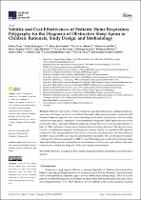Validity and Cost-Effectiveness of Pediatric Home Respiratory Polygraphy for the Diagnosis of Obstructive Sleep Apnea in Children: Rationale, Study Design, and Methodology
Resum
Paraules clau
Anàlisi de cost-efectivitat; Apnea obstructiva del son (OSA); Poligrafia respiratòria
Citació recomanada
Oceja E, Rodríguez P, Jurado M, Luz Alonso M, Del Río G, Villar M, et al. Validity and Cost-Effectiveness of Pediatric Home Respiratory Polygraphy for the Diagnosis of Obstructive Sleep Apnea in Children: Rationale, Study Design, and Methodology. Methods Protoc. 2021 Jan 19;4(1):9.
Audiència
Professionals
Empreu aquest identificador per citar i/o enllaçar aquest document
https://hdl.handle.net/11351/6154Aquest element apareix a les col·leccions següents
- HVH - Articles científics [2972]
Els següents fitxers sobre la llicència estan associats a aquest element:

